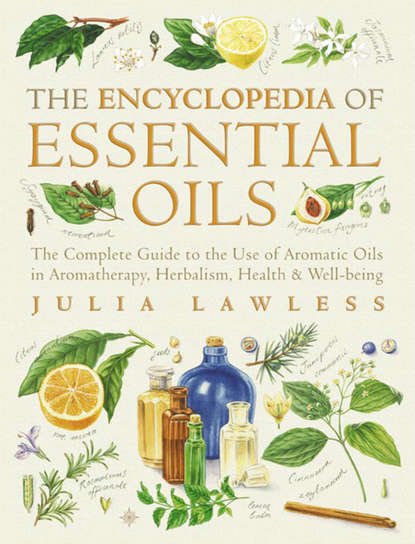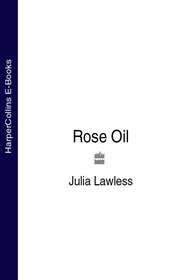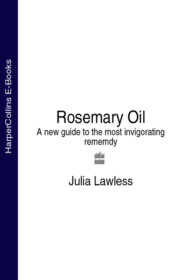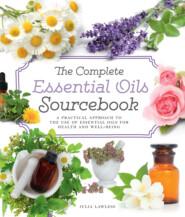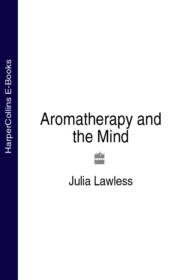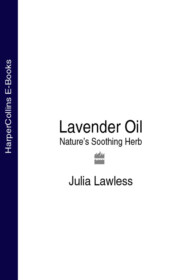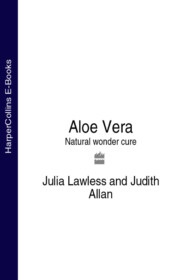По всем вопросам обращайтесь на: info@litportal.ru
(©) 2003-2024.
✖
Encyclopedia of Essential Oils: The complete guide to the use of aromatic oils in aromatherapy, herbalism, health and well-being.
Настройки чтения
Размер шрифта
Высота строк
Поля
Massage (#ulink_72ecd5a6-3a00-53aa-9298-402483d71392)
This is the method favoured by professional aromatherapists, who usually carry out a full body massage. Specific essential oils are chosen to suit the condition and temperament of the patient, and blended with a base oil, such as sweet almond oil or grapeseed oil.
The essential oil content in a blend should usually be between 1 per cent and 3 per cent depending on the type of disorder. As a general rule, physical ailments like rheumatism or indigestion demand a stronger concentration than the more emotional or nervous conditions. A rough guideline is to say that 20 drops of essential oil is equivalent to one millilitre, so to make a blend it is possible to use the following proportions:
Massage is a relaxing and nourishing experience in itself, not least because of the unspoken communication based on touch, but it also ensures that the oils are effectively absorbed through the skin and into the bloodstream. For general well-being it is beneficial to practise self-massage on specific areas of the body, especially concentrating on the feet and hands. It is also useful to rub those particular parts of the body that are causing discomfort; for example peppermint (in dilution) can be rubbed on the stomach in a clockwise direction to ease indigestion; marjoram can help to relax the neck and shoulders if they are stiff.
Skin Oils and Lotions (#ulink_12d1bf8a-ddb8-516d-b16f-4f3836720105)
The essential oils are prepared in much the same manner as they would be for a massage, except that the base oil should include the more nourishing oils such as jojoba, avocado or apricot kernel oil. The emphasis here is on treating the skin itself and dealing with particular problems. A gentle circular movement of the fingers is often enough for the oils to be absorbed; it is important not to drag on the skin, especially in the delicate areas of the neck and around the eyes. Rose and neroli are good for dry or mature complexions; geranium, bergamot and lemon can help combat acne and greasy skin.
A few drops of essential oil can also be mixed into a bland cream or lotion, or added to a basic face mask, which might include oatmeal, honey or clay together with the pulp of various fruits. In some conditions, such as cold sores (herpes) and athlete’s foot, it is better to use an alcohol-based lotion rather than an oil or cream. This can be made by adding 6 drops of essential oil to 5ml of isopropyl alcohol or vodka. This mixture can be further diluted in a litre of boiled and cooled water for treating open cuts or sores, such as those caused by chickenpox or genital herpes.
Hot and Cold Compresses (#ulink_df14fd3d-ad4f-520b-bfb3-9a86c68c746d)
This is a very effective way of using essential oils to relieve pain and reduce inflammation. A hot compress can be made by filling a bowl with very hot water, then adding 4 or 5 drops of essential oil. Dip a folded piece of cotton cloth, cotton wool or a flannel into the bowl, squeeze out the excess water and place the cloth on the affected area until it has cooled to blood heat, then repeat. Hot compresses are particularly useful for backache, rheumatism and arthritis, abscesses, earache and toothache.
Cold compresses are made in a similar way, using ice cold rather than hot water. This type of compress is useful for headaches (apply to forehead or back of neck), sprains, strains and other hot, swollen conditions.
Hair Care (#ulink_dc8766cf-42f9-535b-8b33-ba2ebbc6bf0a)
The hair can also be enhanced by the use of a few drops of essential oils in the final hair rinse or added straight to a mild shampoo. An alcohol-based scalp rub can also be made by adding 5ml of an essential oil to 100ml of vodka – this method can be used to condition the hair or to get rid of unwanted parasites such as lice and fleas. An excellent conditioning treatment for different types of hair can be made by adding about 3 per cent (or 60 drops) of an essential oil to a nourishing base oil such as olive oil with jojoba or sweet almond oil, massaging it into the scalp, then wrapping the hair in warm towels for an hour or two. Oils such as rosemary, West Indian bay and chamomile all help to condition and encourage healthy hair growth; lavender can be used to repel lice and fleas; bergamot and tea tree can help control dandruff.
An apothecary’s shop where medicaments are being concocted from herbs and distilled oils; from a sixteenth-century manuscript
Flower Waters (#ulink_e49d7c7a-6cff-5c3f-8508-4d16def82485)
It is possible to make toilet or flower water at home by adding about 20 to 30 drops of essential oil to a 100ml bottle of spring or de-ionized water, leaving it for a few days in the dark and then filtering it using a coffee filter paper. Although essential oils do not dissolve in water they do impart their scent to it as well as their properties.
This method can be very helpful in the prevention and treatment of skin conditions such as acne, dermatitis and eczema, and to generally tone and cleanse the complexion. Almost any oil can be used, but the more traditional ones include rose, neroli, lavender and petitgrain; alternatively, blended flower waters can be made to suit specific complexions.
Baths (#ulink_934ba3fd-9bf3-502d-8b5e-0d363cb7d8dd)
One of the easiest and most pleasurable ways of using essential oils is to add 5 to 10 drops of oil to the bath water when the tub is full. Aromatic bathing has traditionally been used as an enjoyable and sensual experience, especially by the Romans; but also to treat a wide range of complaints, including irritating skin conditions, muscular aches and pains, rheumatism and arthritis. An essence such as ylang ylang can be enjoyed as a euphoric aromatic experience in itself; chamomile or lavender can help to relieve stress-related complaints such as anxiety or insomnia; rosemary or pine can help soothe aching limbs. Take care to avoid those oils which may be irritating to the skin.
Vaporization (#ulink_d005a95c-e040-520f-a9f1-59b69bb2cb3d)
A delightful way to scent a room, free of the dust or smoke that can be caused by incense, is to use an oil burner, or aromatic diffuser. Alternatively, a few drops of oil can be placed on a light bulb ring or added to a small bowl of water placed on a radiator. Specific oils can be chosen to create different atmospheres: frankincense and cedarwood have been used traditionally in a ritual context, to create a peaceful and relaxed mood. Vaporized oils such as citronella or lemongrass also provide an excellent way of keeping insects at bay or clearing the air of unwanted smells like cigarette smoke.
At one time, the leaves of juniper and rosemary were burnt to help control epidemics and purify the air. Such oils can help keep the environment free of germs and inhibit the development of infections like the common cold or ’flu. An oil such as myrtle or eucalyptus can be used in the bedroom at night to help clear breathing difficulties or children’s coughs. A few drops may also be put on the pillow or onto a handkerchief for use throughout the day. Always ensure that the oil burner is in a safe place and out of reach of children or pets.
Steam Inhalation (#ulink_fefeec87-6c82-537e-b60e-2e3ec958baaf)
This method is especially suited to sinus, throat and chest infections. Add about 5 drops of an oil such as peppermint or thyme to a bowl of hot water, cover the head and bowl with a towel and breathe deeply for a minute – then repeat. Sitting in a steaming hot bath is another way of inhaling a certain amount of essential oil, but obviously it is not so concentrated. This type of application can also act as a kind of facial sauna: oils like lemon or tea tree can help to unclog the pores and clear the complexion.
Douche (#ulink_f7e858b2-919e-5c15-817e-87c9d76e5a30)
This can be useful to help combat common genito-urinary infections such as thrush, cystitis or pruritis. In the case of candida or thrush, add between 5 and 10 drops of tea tree to a litre of warm water and shake well. This mixture can either be used in a sitz bath, bidet or put into an enema/douche pot, which can be bought from some chemists. Certain oils such as lavender and cypress can also aid the healing process after childbirth.
Olive oil, cosmetic and unguent jars; from Dioscondes’s De Materia Medica, 1543
Neat Application (#ulink_5bb32948-400d-5303-a417-44188977bf8f)
Generally speaking, essential oils are not applied to the skin in an undiluted form. However, there are some exceptions to the rule: lavender, for example, can be applied undiluted to burns, cuts and insect bites, tea tree to spots, and lemon to warts. Certain essential oils such as sandalwood, jasmine or rose make excellent perfumes, dabbed neat on the skin. Beware of those oils which are known to be phototoxic (discolour the skin when exposed to direct sunlight) such as bergamot; irritants such as red thyme; or skin sensitizers such as cinnamon bark. It can also be interesting to make an individual fragrance by blending a selection of oils – see Chapter 5 (#u8672652c-2c3d-520d-84be-f0615ddbbeb7). Certain oils may also be used to perfume linen and clothes or rejuvenate pot pourris: patchouli has been used for centuries in India to scent cloth.
Internal Use (#ulink_7ef0287c-cf2a-5a41-9f10-242494fabb05)
Due to the high concentration of essential oils (and the high toxicity of a handful of essences) it is not recommended that they be taken at home in this manner. The International Federation of Aromatherapists also advises against this method of application. However, since essential oils are readily absorbed through the skin, they can affect the internal organs and systems of the body by external use. In a condition such as arthritis, for example, which indicates a build up of toxins in the joints, the use of dietary measures and herbal remedies can be greatly enhanced by the external application of oils such as juniper and white birch which help to purify the system as well as reduce pain and inflammation at the site of the swelling.
ESSENTIAL OILS SHOULD NOT BE USED AT HOME TO TREAT SERIOUS MEDICAL OR PSYCHOLOGICAL PROBLEMS.
5. CREATIVE BLENDING (#ulink_e02a8137-a2fc-549a-8975-7ffc90b031fa)
Therapeutic and Aesthetic Properties (#ulink_c64de3d4-845e-5f77-8dc7-390add67f937)
Essential oils are blended principally for two reasons: for their medical effects or to create a perfume. When we are using pure essential oils, these are not two different categories but rather two ends of a scale. At one end of the scale we are dealing with the therapeutic; action on a purely physical condition such as backache – at the other end, with an emotional or aesthetic response to a particular odour. But, of course, the individual who is suffering from lumbago also has a psychic or emotional disposition of which they may or may not be aware, which will naturally respond in a more subtle way to a particular blend of oils. Similarly, when we create a personal perfume which expresses the unique personality of an individual through fragrance, it has a generally remedial effect on the person as a whole.
An engraving showing sixteenth-century perfumers at work, with their chemical apparatus; from Brunschwig’s Liber de Arte Distillandi de Compositis, 1512
Therefore, when we are blending oils, even if it is principally for their medicinal properties, it is always worth keeping the fragrance in mind. It is more pleasing to use a remedy that smells attractive to the individual concerned. Some scents can be quite incompatible – a predominantly floral blend, for example, would be unacceptable to the majority of men. How to choose the oils and combine them is very much a matter of personal choice, but there are some useful guidelines to keep in mind.
Correct Proportions (#ulink_1f8e47aa-27e8-5549-ad3c-baf9abea07cc)
For therapeutic purposes, essential oils are usually diluted before being applied to the skin. To make a massage or body oil the essential oil or oils should first be mixed with a light base oil such as grapeseed or sweet almond oil. (See alsoChapter 4 (#udfdd9088-a9e8-5404-aa81-02f6b983bd17), How to Use Essential Oils at Home.) Other oils that could be used for the base include sunflower, hazelnut, safflower, peanut, soya or corn oil – mineral oils, however, are best avoided. The more nourishing and generally thicker oils which include jojoba, avocado, peach or apricot kernel, borage, olive, sesame, evening primrose and also some infused oils such as calendula or St John’s wort can also be included (up to about 10 per cent) in the treatment of specific conditions. A small quantity of wheatgerm oil (about 5 per cent) added to the blend will help to preserve it.
The essential oil content in a blend should usually be between 1 per cent and 3 per cent depending on the type of disorder; as a general rule, physical ailments demand a stronger concentration than the more emotional or nervous conditions. Some oils, such as the high-quality florals including rose and jasmine, have more diffusive power than most other essences – this means that a very small percentage is all that is needed to have a powerful effect, or to influence the character of an entire blend.
Synergies (#ulink_23b1d2ca-5cf8-54a5-9e7c-476b81ed8df3)
The proportions of each essential oil in a blend can also be vital to the effectiveness of the remedy as a whole (many aromatherapy books contain exact recipes for specific disorders). Some oils blended together have a mutually enhancing effect upon one another, so that the whole is greater than the sum of the parts: for example, the anti-inflammatory action of chamomile is supported by being mixed with lavender. When the blended oils are working harmoniously together, then the combination is called a ‘synergy’. ‘In order to create a good synergy, you must take into account not only the symptom to be treated but also the underlying cause of the disorder, the biological terrain, and the psychological or emotional factors involved.’
This is very much the conclusion that Madame Maury reached when she prescribed an IP (or Individual Prescription) for her patients, in which the blended essences were matched not only to their physical requirements, but also to their circumstances and temperament.
In general, oils of the same botanical family blend well together. Also those which share common constituents usually mix well, such as the camphoraceous oils containing a good percentage of cineol, which includes all the members of the Myrtaceae group (eucalyptus, tea tree, cajeput, myrtle, etc.) but also many herbs including spike lavender, rosemary and Spanish sage. Most floral fragrances blend well together, as do the woods, balsams, citrus oils and spices, etc. Rosewood and linaloe combine well together, although they belong to different botanical families, since they both contain a high proportion of linalol and linalyl acetate.
Some oils such as rose, jasmine, oakmoss and lavender seem to enhance just about any blend, and can be found (mainly in an adulterated form) amongst the ingredients of most commercial perfumes – ‘no perfume without rose’.
Some combinations, on the other hand, have an inhibiting power over one another. Essences with a predominance of aldehydes (such as citronella oil containing citronella!), those with mainly ketones (such as sage containing thujone) and those with high amounts of phenols (such as clove oil containing eugenol), when combined with each other tend to ‘pull’ in different directions. However, knowing the precise chemical make-up of each oil is not necessary for creating a good synergy; it is also a matter of getting to know the ‘character’ of each essential oil and trusting the intuition.
Fragrant Harmony (#ulink_f7490d11-1ccb-5793-aa2e-d1117df2823a)
In the nineteenth century, a Frenchman called Piesse instigated a new approach to perfumery work by classifying odours according to the notes in a musical scale. He transposed the idea of musical harmony into the realm of fragrances where the corresponding notes to each scent formed perfectly balanced chords or harmonics when they were combined together.
The purist vision of Piesse has long since been discarded but continues to provide inspiration in perfumery work today since the oils are still divided into ‘top’, ‘middle’ and ‘base’ notes.
The top note has a fresh, light quality which is immediately apparent, due to the fast evaporation rate.
The middle note is the heart of the fragrance, which usually forms the bulk of the blend, whose scent emerges some time after the first impression.





